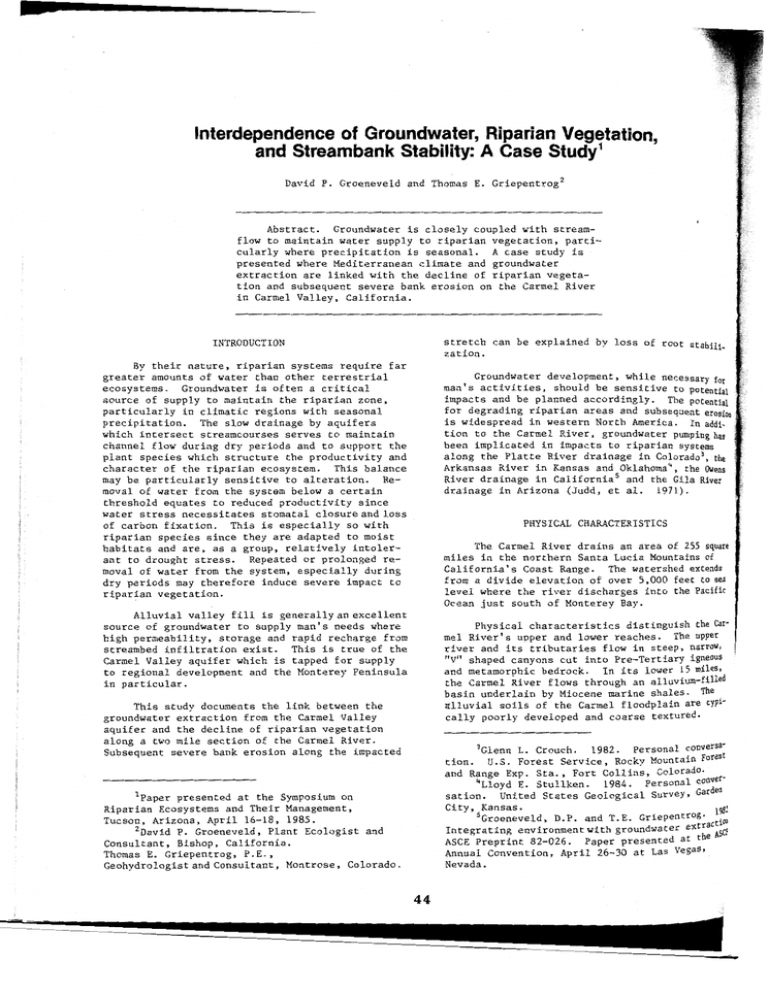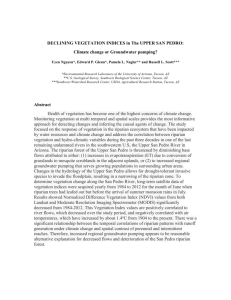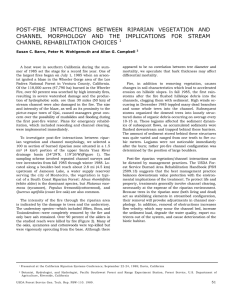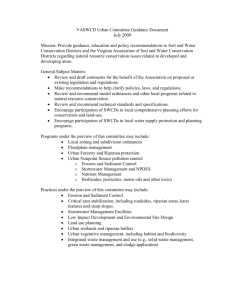Document 10530033
advertisement

...------------- Interdependence of Groundwater, Riparian Vegetation, and Streambank Stability: A Case Study 1 David P. Groeneveld and Thomas E. Griepentrog 2 Abstract. Groundwater is closely coupled with stream­ flow to maintain water supply to riparian vegetation, parti­ cularly where precipitation is seasonal. A case study is presented where Mediterranean climate and groundwater extraction are linked with the decline of riparian vegeta­ tion and subsequent severe bank erosion on the Carmel River in Carmel Valley, California. INTRODUCTION stretch can be explained by loss of root stabili_ zation. By their nature, riparian systems require far greater amounts of water than other terrestrial ecosystems. Groundwater is often a critical source of supply to maintain the riparian zone, particularly in climatic regions with seasonal precipitation. The slow drainage by aquifers which intersect streamcourses serves to maintain channel flow during dry periods and to support the plant species which structure the productivity and character of the riparian ecosystem. This balance may be particularly sensitive to alteration. Re­ moval of water from the system below a certain threshold equates to reduced productivity since water stress necessitates s·tomatal closure and loss of carbon fixation. This is especially so with riparian species since they are adapted to moist habitats and are, as a group, relatively intoler­ ant to drought stress. Repeated or prolonged re­ moval of water from the system, especially during dry periods may therefore induce severe impact to riparian vegetation. Groundwater development, while necessary for man's activities, should be sensitive to potential impac ts and be planned accordingly. The potential for degrading riparian areas and subsequent erosion is widespread in western North America. In addi­ tion to the Carmel River, groundwater pumping has been implicated in impacts to riparian systems along the Platte River drainage in Colorado 3, the Arkansas River in Kansas and Oklahoma 4 , the Owens River drainage in California 5 and the Gila River drainage in Arizona (Judd, et al. 1971). PHYSICAL CHARACTERISTICS The Carmel River drains an area of 255 square miles in the northern Santa Lucia Mountains of California's Coast Range. The watershed extends from a divide elevation of over 5,000 feet to sea level where the river discharges into the Pacific Ocean just south of Monterey Bay. Alluvial valley fill is generally an excellent source of groundwater to supply man's needs where high permeability, storage and rapid recharge from streambed infiltration exist. This is true of the Carmel Valley aquifer which is tapped for supply to regional development and the Monterey Peninsula in particular. Physical characteristics distinguish the Car' mel River's upper and lower reaches. The upper river and its tributaries flow in steep, narrow, "V" shaped canyons cut into Pre-Tertiary igneous and metamorphic bedrock. In its lower 15 miles, the Carmel River flows through an alluvium-filled basin underlain by Miocene marine shales. The ~lluvial soils of the Carmel floodplain are typi­ cally poorly developed and coarse textured. This study documents the link between the groundwater extraction from the Carmel Valley aquifer and the decline of riparian vegetation along a two mile section of the Carmel River. Subsequent severe bank erosion along the impacted 3Glenn L. Crouch. 1982. Personal conversa­ tion. U.S. Forest Service, Rocky Mountain Forest and Range Exp. Sta., Fort Collins, Colorado. 4 Ll oy d E. Stullken. 1984. Personal conver­ sation. United States Geological Survey, Garden City, Kansas. 1982 sGroeneveld, D.P. and T.E. Griepentrog. .~ Integrating environment with groundwater ext~:C~~C! ASCE Preprint 82-026. Paper presented at t Annual Convention, April 26-30 at Las Vegas, Nevada. lPaper presented at the Symposium on Riparian Ecosystems and Their Management, Tucson, Arizona, April 16-18, 1985. 2David P. Groeneveld, Plant Ecologist and Consultant, Bishop, California. Thomas E. Griepentrog, P.E., Geohydrologist and Consultant, Montrose, Colorado. 44 The basin receive s f.r om 14 to 40 inches. of an.n­ r ecip ita tion mos t l y In. the Janu ary-~prll perlod. p inches per year lS the approxlmate r eave rage . The Carmel River discharge averages der 100 c. f. s. on a long-term basis but mea­ u;loW has been as high as 8,62 0 c.f.s. in 1969 l ow dur ing late summer of drier years. zero f DOMI NANT VEGETATION Low water r e tention of the floodplain restricts plants in th e ri parian zone to xeric or phrea t op hytic habit due to the long dr y per i od. The water loving species are ained by sha llow groundwa ter and surface water fr om the recharge r e ce ived during wint e r and precip itati on. Trees dominat e the mature riparian forest al ong Carmel Riv er . Although the composition of the fore s t varies highly with l ocation, with­ the more pr i s tine s tands it is comp os e d of appro­ ely 60 pe rc ent red willow (Salix laevigata), cott onwo od ( Pop ulus trichocarpa), 30 percent o percent Ca lif ornia sycamore (Platanus race­ and white alder (Alnus rhombif ol ia) combined. Two distinct zones of riparian vegetation cover health can be viewed a long the lowe r twelve miles Carme l River . The l owermost four miles infrom t he ocean is over grown with ne arly con­ red wil l ow crown s whe re encroachment has the riparian forest to a strip lini ng the linear eight miles ups t ream have marrip ar ian cover (Fi g. 1) . The bank clumps of the r ema ining ripa r ian tre e spe­ is sparsely v e getat e d with wee dy pe rennials, gras s es and xeric shr ub specie s. The de­ iverbanks h e re s how conspicuous erosion. A portion of this zone was chosen for destudy of vege tation histo ry . Rip a rian Forest Chan ges Thr ough Time The two z ones of r i pari an cover obs erved dur in g fi eld survey is strikingly eviden t on re cent (1 980 ) air pho tographs. By c ontrast, a n ana ly s i s o f pre­ 1960 air photographs indic ated that t he river sup­ ported a continuous cover of riparian f ores t . A series of six photograph s ets of suitable quality we re assembled to document t he change of r ipa rian vegetation thr ough time ; black an d wh ite Un ited State s Soil Con servati on Servi ce ( 1956, 1966 , 19 71 and 1974), Unit e d States Fo re st Serv ice colo r (1978) and colo r infrared obtained from a pr iva t e source (1980). Plant cover obse rved on the air phot ographs wer e mapped onto a bas e prepared from the U. S.G .S. Se a­ side 7.5 minut e quadrangle enlar ged t o 1:6 , 000. A zoom t ransfer scope out fit t ed wi th op tics f or cor­ rect ing dist or tion enab l ed keying the covertypes into correct position and s cale by refer rin g map fea­ tures to the ground images on the air pho tographs. Vegetation mapping ca te go r ies wer e kep t simpl e to accommodate the range in detail observable on the widely differ e nt scale, cont ras t and qua lity of each photo set. Three cover type c a t egories wer e keyed to layer s of ve ge tation grea ter and less than t en fe et in hei ght, and unvegeta ted rive r alluvi um. Canopy height was inferred by c r os s-refe r e ncing eave he i ght on one s tory houses adj a cent t o the fl oodplain using a n ei ght powe r mirror stereosc ope to accentuate three dimensiona l dep t h of fiel d . The streambed was differentiate d fr om t he annual grass meadow cover by te x ture and ton e on the bla ck and white film and by color on t he color inf rare d and color phot o sets. The mature r i parian trees ar e all talle r than ten feet. Theref o re, with in the floodplain , the map category for tree cove r a cc urately r epresents the riparian forest. Field che cking eliminated trees that were plant e d and ma in tai ne d by ma n. The time serie s of maps shown on Fi gure 2 docu­ ments the thinning o f th e rip a rian fo r es t readily observable on the photographs. Loss of ri parian f orest cover over the 24 year pe r i od is v i s ible initially in t he upstream s ec tion t owar d t he righ t of the 1966 map. Gradually the fo r e st cove r les­ sens in the remaining se c tions o f t he study area until, by 197 8 , t he riparian forest cover is dis­ continuous wi t h much of th e remainin g vege t atio n surviving at some distan ce from the channel margins. In 1980, the ri parian cover is re duce d even fu r ther and t he riv e r channel has widene d dramatical l y, particularly in the downs t r eam sections. , N I SCALE IN MILES o Foll owin g further analys is , tr ee pa thoge ns, fi re and enc roa chment by ma n we re r uled out as pos­ sible caus al a gents for the decline o f th e r iparian forest. The decrease of rip arian tre e s c oinc ides with the g radual devel o pment of t he Mont e r e y Penin ­ sula and the wells to exp ort groundwa t e r to meet the increasing demand. The wel l f ie ld extrac ts water from the river alluv i um wi t hin the zone of vegetation impact noted both in t he fiel d and on the ai r pho to ­ graphs. The op er a ting we l ls in th e vegetatio n study area are indicated on Figur e 2 in the s e­ quen c e of development a nd us e. C l·--The l owe r Carme l River Region. on t our i ntervals a re 1 ,000 f eet. 45 down in the system so the drawdown f rOm p ten d s to be greatest during late s umpinD . ummer a d " Th e f . ~ve foot ~socontour of groundwater dn fall. from the spring high levels to an 0 raWd~ ctober 1 " 1 potted on F~gure 3. These zones of" ow afe " 1e the export wells and corres mf~ c~rc pon d wellenee ~,;..~ the zones of riparian vegetation d 1" With 2 ec 1ne on Fi . gure Figure 2.--Time series maps of the study area with the riparian forest indicated. The study area is divided into 4 sections according to the location of high capacity export wells. GROUNDWATER HYDROLOGY AND PLANT RESPONSES A water budget assessment of the study area was made for the study area which included quanti­ fying gains and losses to the system. Recharge to the study area comes directly from precipitation on the valley floor, runoff from the bordering valley sides and tributaries, deep percolation from surface irrigation and septic systems, agri­ culture return flow, down-valley groundwater flow through the alluvium and in the river channel. Disposition occurs via evaporation transoiration consumptive domestic uses, outflow'of the" Carmel' River, downgradient drainage through the alluvial aquifer and from pumping for export. Based upon conservative estimates, the water budget indicated that local consumptive use as an annual total was only about eight percent of the aquifer capacity and was spread throughout the year. By contrast, pumping for export was seen to demand a large proportion of the aquifer capacity. The down valley groundwater flow and infiltration from the channel flow, when available, tend to re­ charge the basin at a rate slower than pump extrac­ tions. This recharge somewhat buffers the draw- Figure 3. --Zones of inf luence in October for four select years. The 5 foot isocontour of draw­ down from the spring high is the zone boun­ dary. The limits of the valley fill are indicated. Riparian Water Requirements Young and Blaney (1942) measured water con­ sumption by willow in Santa Ana, California to be about 56 inches during the period from June through September. It is reasonable to assume that willow and other riparian vegetation within the slightly more humid Carmel Valley would transpire at least 30 inches per year through the same period. The average June throu~h September precipitation is less than one inch confirming that willowS and other riparian vegetation are groundwater depen­ dent. 6 United States Weather Bureau Records. Valley, California. Catlllel Tree Roo t s an d Declining Water Tab l es 75 ­ An i mplie d question is posed by the hyd rol o­ l ys i s : can the roots of riparian phrea t o­ ana fo lloW a retreatlng . water ta bl e ?. To answer tion, s oil pits were dug a ro und the base willow (~. laev i gata ) in the study area lat e summer. The ro ots of the r e d willow only to a depth delimiting the be d ele­ of the adjac ent dry channel . Thes e roots quite fra gil e and spongy due to the presence cortical air sp ace s. .-­ SCHULTE 75 ­ :;0 - cortical air spaces c al le d ae renchyma, are stic of many wetland species. The air ar ise by lysis wi t hin parenchymal tissue have been f ound to improve oxygenation to root (Coutts and Armstrong, 1978), (Kawase and ,1980) . This morphologic adaptation, , probably reduc e s the penetrating power root tips because the induced sponginess both the axial ri gidity and radial ancho­ cited by Barley and Greacen (1967) as nece s­ for efficient soil penetration by roots. • 1000 MANOR :-----::> 19 60 ':i,dJ ,"oc 1970 1980 BEGONIA 75 ­ Black cottonwood roots in the vicinity of the t est pits were undercut and washed free t he bank. The se roots showed the same p a t­ of truncati on at about the elevation of the t channel noted for the red willow. 50­ .-­ I 2 5­ e 1.) . • It «< 1950 The reason that th e observed willow and co t ­ root systems had not adapted t o follow water t able retreat may be due to soils flo odplain . The f loodplain subs t rate is coarse an d retains only small amounts of wat er drainage . Thrs restrict s contact o f matrix films afte r complete dr ainage fr om pumping. necessary for inducing deep e r rooting fore probably broken during r apid wa ter line. Poplars, of wh ich t he bl a ck co ta member, have been observed by Hoff­ , as cited by Kr amer a nd Kozl owski, 1979) five centime ters per day growth rates. rates are, of course, moderated by soil im­ and the timing r equired for redifferen­ root buds f r om ae renchyma tous tissue to more suited for exploring the soil . Sequence of Events Each of the covertype maps shown in Fig . 2 fitted with a cl ear template delimiting a ri­ corr i dor along the river. The study area divided into s e c tions conforming to the loca­ of high capa city wells designated fr om down ; Schul te, Manor, Berwick and Begonia. plan ime t e r was used to obtain three replica­ of the area of the riparian forest and unve­ ed river al luvium cover types. . These values ave r aged to yield da ta documen t i ng t he tern­ rela tionship of ripari a n v e ge tat ion de cline, channel erosion and pumping 7 plotted on ••• . . . ... .::. i. -1000 e-e - 500 198 BERWICK Figure 4.--Perce nt cover by riparian f or est (diamond s) and unvegetate d river ch2nne l (c i rcles) ver sus pump i n g i n a c re feet f r om wells in each s e c t ion. PUMPING, VEGETATION DECLINE AND CHANNEL EROSION Kondolf (19 83) ana lyzed the geomorphology of t he Carmel River system to det erm i ne the cause and ef fe ct relationship for the mass i v e streamba nk ero sion by measuring such parameters a s river sinuosity, bed load, gr ad ient and c hanne l con figur­ at"ion in relation to influencing fact or s s uch as historic fires in the catchme nt basin, streambed minimg , construction of dams upstr e am and the timing and rate of river f l ows. Kond olf conc luded that although j'some bank e ro s i on i s natur al in most fluvial systems '" nat ural, random proces s i s inadequate to exp lain t he ma ss ive bank e r osion experienced along the Ca rmel Rive r in 1978 . Th is erosion must be r e garded as out of the ord inary in t hat it occurred during ye ars unremarka ble for high flows." After leng thy e xamination of t he phy ­ sical sys t em, Kondolf c onc lude d that the bank ero­ sion was coupled with groundwater pumpin g through dieoff of riparian v egetation . Streamba nk stab ili zation by vegeta t i on resul ts fr om the reinforcing natu r e of t he plan t r oots . This mechanism is documented in the lit er a ture and though limited discus sion wil l be made here, the re ader is urged to s e e Smith ( 1976 ) , Seibe r t (1 96 8 ), Ziemer (1981) a nd Gray and Leiser (1 982) f or more background. In summary , streambank s t abiliz a t i on by ro ot s results f rom i nc r ease d t ens i le and she a r 4. 7 Pump produc ti on r ec ords obtained from t he ornia-Amerl. can Wa ter Company . 47 strength of the bank soil mass and through armor­ ing provided by roots as they wash free from the substrate. These mechanisms were obviously lack­ ing for the readily erodable bank material within the impact area. The most severe erosion of streambanks on the Carmel River occurred within the study area. A time series of photographs taken from the Schulte Road Bridge looking upstream document the process of bank erosion following loss of stabilizing plant growth (Figures 5, 6 and 7). The photo point can be located on the maps of Figure 2 as the double line between the Schulte and Manor sec­ tions of the river. The 1976 photograph was taken in late fall 1976 and shows dead cottonwoods and willows lining the approximately 60 foot wide channel. The 1978 photograph captures the same scene following spring high water flows which equate to a ten year recurrence interval (Kondolf, 1983). Note that the toe of the bank has been eroded back about 30 feet from the channel margin position visible in 1976. According to photogram­ metry of the 1978 air photograph set, the erosion due to this flow resulted in an ultimate channel width of about 150 feet within the field of view of the photograph. A photograph following spring high water flows in 1982 illustrates the same scene but with aggradation of the margins to form a channel over 400 feet wide. This erosion occurred following two five year recurrence inter­ val flows in the intervening four year period. Figures 5,.6 and 7.--1976 8 , 1978 6 and 1982 graphs of the Carmel River Channel. thhoto~ arrow indicates a reference point. e LITERATURE CITED Barley, K.P., and E.L. Greacen. 1967. Mech i . . . ~~ reSl.stance as a sOl.l factor influencing the growth of roots and underground shoots. Advances in Agronomy, 19:1-43. Coutts, M. P. and W. Armstrong. 1978. Role of oxygen transport in the tolerance of trees to waterlogging. In M. C. R. Cannell and F. T. Last (eds.) Tree physiology and yield improvement. Academic Press, New York. Gray, D.H. and A. Leiser. 1982. Biotechnica1 slope protection and erosion control. v~ Nostrand Reinhold, N.Y. 271 pp. Judd, B. Ira, James M. Laughlin, Herbert R. Guenther and Royal Handegarde. 1971. The lethal decline of mesquite on the Casa Granl National Monument. Great Basin Naturalist. 31:153-159. Kawase, Makoto and Robert E. Whitmoyer. 1980. Aerenchyma development in waterlogged plant Amer. J. Bot. 67:18-22. KondoH, C.M. 1982. Recent channel instability and historic channel changes of the Carmel River, Monterey County, California. M.S. Thesis. University of California at Santa Cruz. 112 pp. Kramer, P.J., and ToT. Kozlowski. 1979. PhysiC logy of woody plants. Academic Press, New York, N.Y. 809 pp. Seibert, P. 1968. Importance of natural veget; tion for the protection of the banks of streams, rivers and canals. In Fresh~ater Studies, Nature and Environmental Senes. Council of Europe, Strassbourg. 3: 35-64. Smith, D.C. 1976. Effect of vegetation on anastamosed channels of a glacier meltwate . river. GSA Bull. 87: 857-800. Young, Arthur A. and Blaney, Harry F. 1942. Use of water by native vegetation. Calif. D~p. Public Works Div. Water Resour. 50: 150 pp. Ziemer, R.R. 19~1. Roots and stability of forested slopes. In Erosion and sedime~ transport in Pacific Rim steeplands. I Pub. No. 132: 343-361. SEd Lee. 1982. Photographs of the Carmel River. Board of Directors, Monterey Peninsula Water Management District. 48







